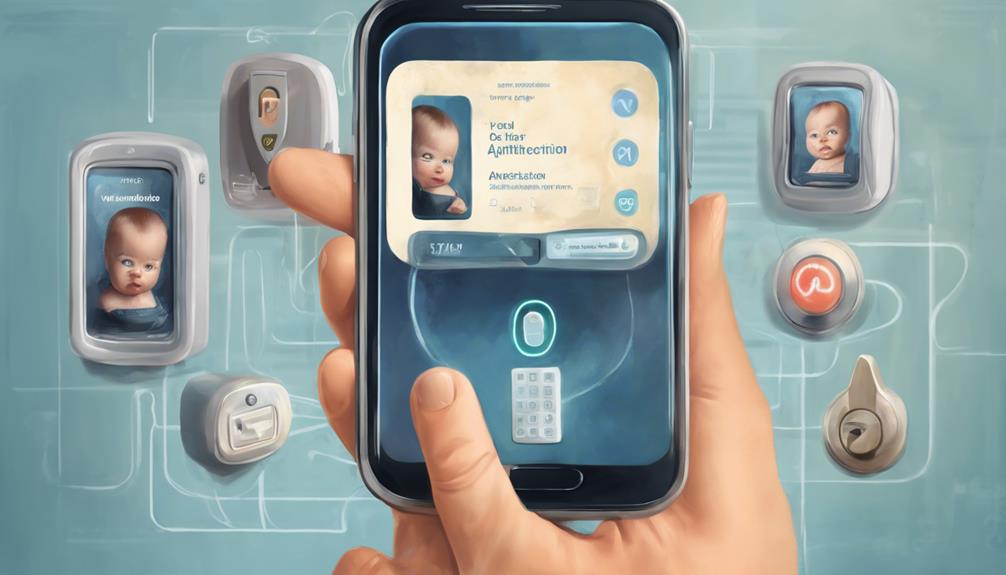FHSS and DECT baby monitors offer robust security against hackers. These technologies use Frequency-Hopping Spread Spectrum and encryption to safeguard data. Choosing non-WiFi monitors with FHSS or DECT guarantees minimal interference and secure communication channels. Implement strong passwords and enable two-factor authentication to strengthen defenses. Vulnerabilities lie in Wi-Fi models due to easily guessed default passwords. Opt for monitors with advanced encryption features and regular firmware updates. High-quality IP monitors with strong encryption mechanisms from reputable brands further enhance security. Taking these measures greatly reduces the risk of unauthorized access and keeps sensitive information safe. Additional details can provide a deeper understanding.
Key Takeaways
- FHSS or DECT monitors offer secure, encrypted communication.
- Non-WiFi models with FHSS or DECT tech prevent hacking.
- Strong passwords and firmware updates enhance security.
- Avoid Wi-Fi monitors for lower vulnerability to hackers.
- Quality IP monitors with robust encryption deter unauthorized access.
Secure Transmission Technologies
Secure transmission technologies play a pivotal role in ensuring the privacy and safety of data exchanged through baby monitors. FHSS technology, utilized in some baby monitors, employs Frequency-Hopping Spread Spectrum to transmit data securely by constantly changing the frequency of the signal.
DECT baby monitors, another secure option, offer digital communication with minimal interference, enhancing the protection of transmitted information. Non-WiFi baby monitors equipped with FHSS or DECT technology provide heightened security against potential hacking threats compared to WiFi-enabled devices.
These technologies create a secure communication channel that reduces the risk of unauthorized access to the baby monitor feed, ensuring that caregivers can monitor their infants without concerns about privacy breaches. By choosing baby monitors with secure transmission technologies like FHSS or DECT, parents can have peace of mind knowing that their baby's data is safeguarded from external threats and unauthorized access.
Advantages of FHSS/DECT Monitors

FHSS/DECT baby monitors offer a heightened level of security through their innovative Frequency-Hopping Spread Spectrum technology. By constantly switching frequencies, these monitors create a barrier that thwarts potential hacking attempts.
Additionally, the encryption utilized in FHSS/DECT monitors adds an extra layer of protection, ensuring secure and interference-free communication between the baby and parent units.
Secure FHSS Technology
Frequency-hopping spread spectrum (FHSS) technology utilized in baby monitors provides a reliable and secure method of transmitting audio and video data. This technology guarantees secure communication by employing encryption and frequency hopping, where data is transmitted across different frequencies in a random pattern.
The encryption used in FHSS monitors adds a layer of protection, making it difficult for unauthorized parties to intercept or access the transmitted information. By constantly changing frequencies, FHSS monitors reduce the risk of signal interception, enhancing privacy during the transmission process.
Compared to Wi-Fi monitors, FHSS technology offers a more secure option for parents, as the frequency hopping mechanism minimizes the chances of hacking and unauthorized access. The unique frequencies assigned to FHSS monitors contribute to their safety from hackers, providing peace of mind to users regarding the privacy and security of their baby monitor transmissions.
Encrypted DECT Signals
By utilizing encrypted signals, DECT technology in baby monitors provides an additional layer of security against hacking attempts, safeguarding the confidential transmission of audio and video data.
DECT monitors employ Frequency-Hopping Spread Spectrum (FHSS) to enhance the security of their communication channels. Through the use of encrypted signals, DECT monitors offer a secure transmission environment, protecting sensitive information from potential breaches.
The encryption of DECT signals helps mitigate the risk of unauthorized access to the baby monitor system, making it a dependable choice for parents seeking privacy and protection for their child monitoring needs.
The utilization of FHSS in DECT technology ensures that the transmission of audio and video data is resistant to interference and eavesdropping, further bolstering the overall security of the monitoring system.
With encrypted signals and FHSS technology, DECT monitors stand out as a safe and secure option for parents looking to monitor their baby without compromising on privacy and data integrity.
Vulnerability of Wi-Fi Models

Wi-Fi baby monitors are particularly susceptible to hacking due to their internet connectivity, presenting a significant vulnerability for users concerned about privacy and security. Hackers often target Wi-Fi models due to their weak default passwords, making them easy entry points for unauthorized access.
Exploiting Wi-Fi vulnerabilities, hackers can compromise the security of these monitors, potentially invading the privacy of families. In contrast to FHSS technology used in non-Wi-Fi models, which offers more secure communication, Wi-Fi baby monitors are at a higher risk of monitor hacking incidents.
To mitigate these risks, it is advisable for users to opt for non-Wi-Fi baby monitors or make sure that their Wi-Fi models are secured with strong encryption and unique passwords. Taking proactive measures to safeguard the internet-connected baby monitor is essential in protecting sensitive information and ensuring the safety of infants and toddlers in today's digital age.
Implementing Strong Passwords

To enhance the security of internet-connected baby monitors, one effective measure is implementing strong passwords that incorporate a mix of letters, numbers, and special characters. Strong passwords act as a barrier against unauthorized access, safeguarding the privacy and safety of the monitored area.
It is essential to use unique passwords for each device and update them regularly to prevent potential breaches. Common or predictable passwords like '1234' or 'password' should be avoided at all costs to guarantee the highest level of security for the baby monitor system.
Password managers can assist in creating and managing complex passwords, further fortifying the defense against hacking attempts. By prioritizing the implementation of strong passwords, users can establish a foundational layer of security that reduces the risk of unauthorized access to their baby monitors.
Enabling Two-Factor Authentication

Two-factor authentication is an essential security measure that adds an extra layer of protection to baby monitors. By requiring a second form of verification, such as a unique code sent to the user's phone or email, it greatly reduces the risk of unauthorized access.
Implementing this feature is vital to safeguard sensitive data and prevent hacking attempts on these devices.
Two-Factor Authentication Basics
Enhancing the security of your baby monitor account involves implementing two-factor authentication as a fundamental security measure. Two-factor authentication provides an extra layer of security by requiring not only something you know, like a password, but also something you have, such as a code sent to your phone.
By enabling two-factor authentication on your baby monitor account, you can greatly reduce the risk of unauthorized access, even if your password is compromised. This widely recommended security measure is essential for safeguarding sensitive accounts, as it adds an additional verification step beyond just entering a password.
It is important to take advantage of two-factor authentication to enhance the protection of your baby monitor system and make sure that only authorized individuals can access the feed securely. By implementing this basic yet effective security measure, you can significantly decrease the likelihood of potential hacking incidents and protect your privacy and security.
Security Code Importance
Implementing two-factor authentication on your baby monitor account provides an added layer of security against unauthorized access. This security measure requires users to input a security code, in addition to their password, to log in successfully.
By incorporating two-factor authentication, users receive a unique security code either through text messages or specialized apps for each login attempt. Hackers face increased difficulty in breaching baby monitors protected by two-factor authentication, greatly reducing the risk of unauthorized access.
This additional step in the login process acts as a barrier against potential intruders attempting to gain control of your baby monitor. By utilizing unique security codes, users can make sure that only authorized individuals can access the baby monitor system, enhancing overall security and peace of mind.
Essentially, the use of two-factor authentication with its requirement of a security code plays a significant role in safeguarding your baby monitor from cyber threats and unauthorized access attempts.
Authentication App Usage
To further strengthen the security of baby monitor accounts, the utilization of authentication apps for enabling two-factor authentication is a recommended approach. Two-factor authentication adds an extra layer of security by requiring a second verification step, which is important in safeguarding sensitive information.
Authentication apps such as Google Authenticator or Authy generate unique codes for logging in, enhancing the protection of accounts from unauthorized access. This method is particularly vital as it helps prevent breaches even if passwords are compromised.
By using an authentication app, the risk of hackers bypassing security measures is greatly reduced, providing added peace of mind to users. Authentication apps are widely recognized for their effectiveness in securing various online accounts, making them a reliable choice for bolstering the security features of baby monitors.
In conjunction with strong passwords and regular firmware updates, enabling two-factor authentication through authentication apps is a proactive step towards enhancing the overall security of baby monitor systems.
Opting for Local Storage

Utilizing baby monitors equipped with local storage functionality strengthens the security measures against potential hacking threats. By opting for baby monitors with local storage, the likelihood of unauthorized access to sensitive footage is greatly diminished. Local storage guarantees that recorded data is saved directly to the monitor or a separate device within your home network, eliminating vulnerabilities associated with cloud-based storage. This approach prevents hackers from breaching cloud servers to access recorded videos, providing a more secure environment for monitoring your baby.
| Advantages of Local Storage | |
|---|---|
| Strengthened Security Measures | Reduced Risk of Unauthorized Access |
| Data Stored Within Home Network | Protection Against Cloud-Based Vulnerabilities |
| Prevention of Hacking Attempts | Secure Environment for Monitoring |
Preventing Hacking With Fhss/Dect

FHSS/DECT baby monitors employ advanced Frequency-Hopping Spread Spectrum technology, enhancing the security of data transmission. By swiftly jumping between different frequencies, these monitors reduce the risk of unauthorized access, bolstered by robust encryption protocols.
Opting for FHSS/DECT models can notably enhance cybersecurity measures, providing reassurance to parents concerned about potential hacking threats.
FHSS Security Features
One of the key features that sets FHSS baby monitors apart from other types is their advanced security measures, specifically designed to prevent hacking attempts. FHSS technology, utilized in these monitors, operates by constantly changing frequencies, making it challenging for hackers to intercept the signal.
DECT baby monitors, on the other hand, offer a secure connection with encrypted audio and video transmissions, ensuring that the communication remains confidential.
Compared to Wi-Fi monitors, FHSS/Dect baby monitors are less vulnerable to hacking due to their robust security protocols. The frequency hopping characteristic of FHSS technology adds an extra layer of protection, further enhancing the security of these devices.
DECT Encryption Benefits
DECT encryption plays a vital role in enhancing the security of baby monitors, effectively thwarting hacking attempts by guaranteeing the confidential transmission of audio data. Through the utilization of FHSS (Frequency Hopping Spread Spectrum) technology, DECT monitors change frequencies rapidly, making it challenging for potential hackers to intercept the signal. This dynamic frequency hopping not only minimizes interference but also adds an extra layer of security, reducing the risk of unauthorized access to the audio feed.
By establishing a secure connection between the baby unit and the parent unit, DECT encryption ensures that sensitive information is encrypted, safeguarding it from potential breaches. Opting for a DECT baby monitor provides caregivers with peace of mind, knowing that the communication channel is well-protected and resistant to hacking attempts.
The implementation of DECT encryption in baby monitors underscores the commitment to maintaining privacy and security in monitoring infants, offering a reliable solution for modern parents seeking a secure monitoring system.
Importance of Quality IP Monitors

The importance of investing in high-quality IP baby monitors lies in their robust encryption and security features, which play an essential role in safeguarding against potential hacking threats.
Wi-Fi baby monitors equipped with strong encryption mechanisms can help prevent unauthorized access by hackers.
Opting for reputable brands known for their secure IP monitors can offer an added layer of protection against cyber threats.
Additionally, ensuring regular firmware updates on your IP monitor is pivotal to patch any security vulnerabilities and enhance its overall protection against hacking attempts.
By prioritizing these security measures, parents can have peace of mind knowing that their baby monitor is equipped with the necessary defenses to keep their child safe.
Resetting Default Passwords

Resetting default passwords on baby monitors is an essential security measure that helps prevent unauthorized access and potential hacking incidents. Security experts emphasize the importance of changing default passwords to unique, strong ones to safeguard your baby monitor effectively. Here are five key reasons why resetting default passwords is vital:
- Default passwords are often generic and easily exploited by hackers.
- Changing to unique, strong passwords adds an important layer of security.
- Failure to reset default passwords increases the risk of unauthorized access.
- Regularly updating passwords and security settings can prevent your baby monitor from potential hacks.
- Security experts recommend immediate action to reset default passwords to enhance the protection of your device.
Taking these steps can greatly reduce the vulnerability of your baby monitor to cyber threats and unauthorized intrusions, ensuring the safety and privacy of your family.
Upgrading and Updating Devices

Consistently updating and upgrading your baby monitor devices is essential to enhancing their security features and protecting against potential hacking threats. By ensuring that you regularly install software updates and security patches, you can effectively safeguard your devices against monitor hacks. Upgrading to baby monitors equipped with advanced encryption and security features provides an additional layer of protection, making them less vulnerable to security breaches. Additionally, opting for non-Wi-Fi baby monitors that utilize FHSS technology can offer a more secure connection, reducing the risk of unauthorized access by hackers. Choosing unique passwords and usernames for your devices further enhances security measures, preventing easy entry for malicious actors. Installing a VPN on your router can also help encrypt data transmissions, adding an extra level of protection against potential hacking attempts on your baby monitors.
| Security Measure | Description |
|---|---|
| Software Updates | Regularly installing firmware updates can patch vulnerabilities, enhancing security against hacks. |
| Advanced Encryption | Upgrading to monitors with advanced encryption features can provide increased protection from hackers. |
| Unique Passwords and Usernames | Choosing unique login credentials prevents easy access for hackers, bolstering device security. |
| Non-Wi-Fi Baby Monitors | Opting for FHSS technology in non-Wi-Fi monitors offers a more secure connection against hacking. |
| VPN Installation on Router | Installing a VPN on your router encrypts data transmissions, adding an extra layer of protection. |
Frequently Asked Questions
Is Owlet Safe From Hackers?
Owlet baby monitors have robust security features, including encrypted communication, secure Wi-Fi connectivity with password protection, and regular software updates to address vulnerabilities. The brand prioritizes user privacy and employs strong measures to prevent hacking threats.
Should I Avoid Wi-Fi Baby Monitors?
When considering baby monitors, avoiding Wi-Fi models can enhance security against potential hackers. Non-Wi-Fi options like FHSS or DECT utilize secure technologies such as frequency hopping, reducing the risk of unauthorized access and ensuring a safer monitoring experience for parents.
Which Baby Monitor Is Safe for Privacy?
When seeking a baby monitor for privacy, consider FHSS technology for secure frequency hopping, analog monitors for limited hacking risks, non-Wi-Fi options with encryption, models with strong password protection and regular updates, and reputable brands prioritizing security features.
Can Someone Hack Into Nanit?
In the domain of baby monitor security, the question arises: Can someone hack into Nanit? With its robust encryption, secure logins, regular updates, and two-factor authentication, Nanit stands tall as a guardian against unauthorized intrusions, assuring users of its steadfast protection.
Conclusion
In the ever-evolving landscape of baby monitor security, it is imperative to prioritize safety measures that prevent hacking incidents.
By utilizing secure transmission technologies like FHSS/DECT, implementing strong passwords and two-factor authentication, as well as regularly updating devices, parents can safeguard their baby monitors from potential threats.
Just as a vigilant guard protects a castle from intruders, these measures act as a shield against digital invaders, ensuring the privacy and security of families.









